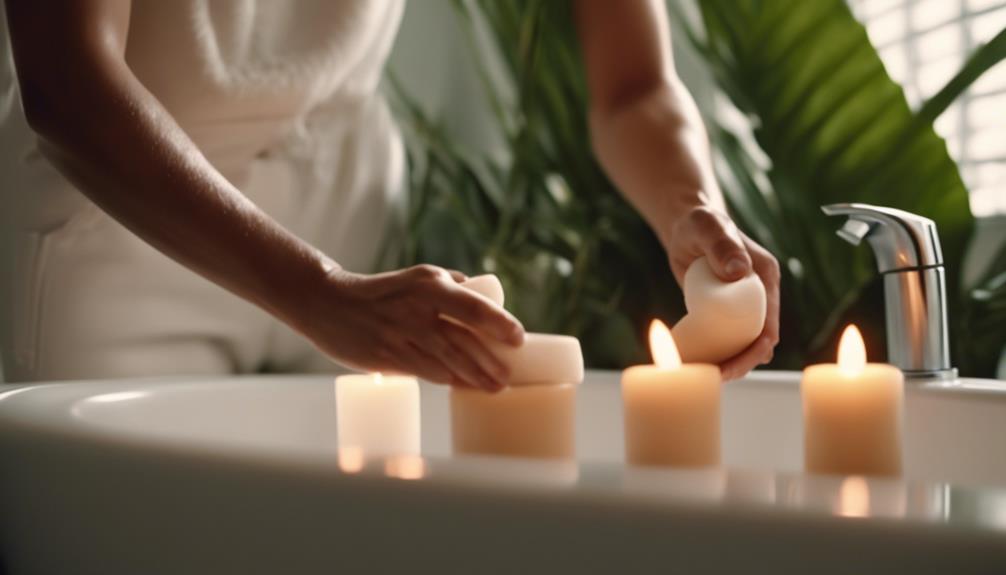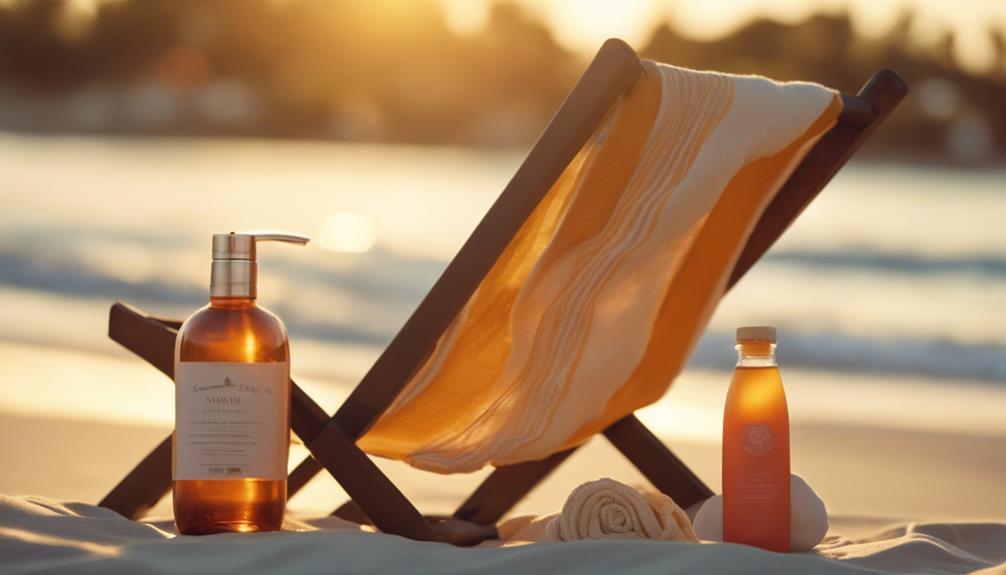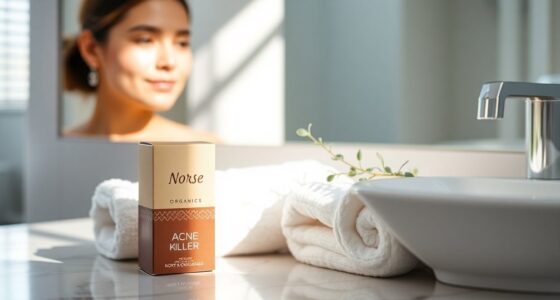You can achieve a flawless tan without sun exposure by following a few easy steps. Start by exfoliating your skin to remove dead cells and prep it for even application. Choose a self-tanner that suits your skin type and desired shade. Use a tanning mitt, applying the product in circular motions for a streak-free finish. Don't forget to moisturize daily to maintain your tan and guarantee an even glow. If you notice any uneven spots, blend them with lotion. For more tips on making your tan last, you might want to explore additional techniques and products.
Key Takeaways
- Exfoliate your skin thoroughly before applying self-tanner to ensure a smooth and even application.
- Choose a self-tanner suitable for your skin type to achieve the desired shade and finish.
- Use a tanning mitt and apply self-tanner in circular motions for a streak-free and even distribution.
- Moisturize daily to maintain your tan and prevent dryness, enhancing the overall glow of your skin.
Preparation for Self-Tanning
Before you plunge into self-tanning, it's important to prepare your skin for a flawless application.
Start by exfoliating thoroughly; this removes dead skin cells and helps achieve an even glow. Focus on areas prone to dryness, like your knees, elbows, and ankles, using a gentle scrub in circular motions.
Next, make sure your skin is completely dry before applying any self-tanner. Use a quality tanning mitt for a smooth application, and apply moisturizer to your hands and feet to avoid any unwanted orange tones.
This preparation not only enhances your self-tanner's effectiveness but also guarantees your tan lasts longer.
Choosing the Right Self-Tanner
Choosing the right self-tanner is essential for achieving a natural-looking glow without the risks of sun exposure. Start by considering your skin type and desired shade. Test different formulas to find the one that complements your complexion and fits your lifestyle. High-quality brands typically provide better results and a more pleasant scent.
| Skin Type | Best Self-Tanner Type | Key Features |
|---|---|---|
| Oily | Gel or mousse | Lightweight, quick-drying |
| Dry | Cream or lotion | Hydrating, rich formula |
| Combination | Oil-free lotion or spray | Versatile, easy to blend |
Application Techniques for Even Tan

To achieve an even tan, mastering the application techniques is just as important as selecting the right self-tanner for your skin type.
Start by using a quality tanning mitt to guarantee smooth application. Apply the self-tanner in circular motions, which helps distribute the product evenly across your skin.
Don't forget tricky areas like elbows and knees; they tend to absorb more color, so apply lightly there. Always make certain your skin is dry and well-exfoliated before you begin.
After applying, allow enough drying time before dressing to prevent any transfer. Finally, check for missed spots and blend any uneven areas immediately.
These steps will help you achieve a flawless, sun-kissed glow without stepping outside.
Maintaining Your Self-Tan
Maintaining your self-tan requires consistent care to keep your skin hydrated and your glow looking fresh. Here are three key tips to help you achieve a lasting tan:
- Moisturize Daily: Apply a hydrating lotion every day to lock in your tan and prevent dryness. Look for formulas that are oil-free to avoid fading.
- Gentle Exfoliation: Exfoliate lightly every few days to maintain an even appearance without stripping away your color. Focus on areas prone to dryness.
- Limit Water Exposure: Reduce long baths and excessive sweating to preserve your tan. When swimming, use waterproof sunscreen to protect your skin.
Fixing Uneven Tan Areas
Even with diligent care, you might notice uneven tan areas that need fixing for a flawless finish. To achieve this, start by blending self-tanner carefully, especially around joints and dry spots. Pre-moisturizing these areas helps prevent darker patches from forming.
After application, conduct a visual check for any missed spots or unevenness. If you find overly dark areas, use a lotion to lighten them; simply apply it to the affected areas and blend gently.
Hydration and Skin Protection
Hydrating your skin regularly plays an essential role in achieving and maintaining that sun-kissed glow while also protecting it from damage.
When you keep your skin moisturized, you enhance its elasticity and appearance, making your tan look even better.
Here are three key benefits of hydration:
- Locks in Moisture: Daily moisturizing helps retain your tan by preventing dryness and flakiness.
- Enhances Skin Health: Well-hydrated skin looks plumper and healthier, contributing to a more radiant glow.
- Prevents Tanner Stains: Using a barrier cream with your moisturizer shields your hands and feet from unwanted stains during application.
Essential UV Protection Tips

Protecting your skin from UV damage is just as important as keeping it moisturized for a healthy, glowing appearance. Follow these essential tips to guarantee your skin stays safe while you enjoy your self-tanner.
| Tip | Details |
|---|---|
| Use SPF 30 or higher | Apply generously, covering all exposed areas. |
| Avoid peak sun hours | Stay indoors between 10 AM and 4 PM. |
| Accessorize for protection | Wear wide-brimmed hats and sunglasses. |
Additional Self-Tanning Resources
You'll find a wealth of additional self-tanning resources that can help you achieve that perfect sun-kissed glow. To enhance your self-tanning experience, consider these tips:
- Self-Tanning Techniques: Always exfoliate before applying self-tanner for a smooth canvas. Use a tanning mitt to achieve an even, streak-free finish.
- Optimizing Self-Tan Results: Apply an oil-free lotion on dry areas to prevent uneven absorption. Allow sufficient drying time to guarantee your color develops evenly.
- Related Posts and Resources: Check out articles like '6 Healthy Tanning Bed Alternatives for Glowing Skin' or '10 Best Tanning Bed Face Covers for Ultimate UV Protection' for more insights.
Utilizing these resources will help you achieve a flawless tan without the sun's harmful rays.
Happy tanning!
Frequently Asked Questions
Can Self-Tanners Be Used on Sensitive Skin Types?
Yes, self-tanners can be used on sensitive skin types, but you should choose formulas specifically designed for sensitivity. Always patch-test a small area first to guarantee you won't experience irritation or adverse reactions.
How Long Does a Self-Tan Typically Last?
A self-tan typically lasts between five to seven days, depending on your skin type and care. To prolong it, moisturize daily and avoid excessive water exposure to maintain that beautiful glow as long as possible.
Will Self-Tanner Stain My Clothes or Sheets?
Ever spilled coffee on your favorite shirt? Self-tanner can stain clothes and sheets if you don't let it dry completely. To avoid mishaps, wear dark clothing and give your tan ample drying time.
Can I Use Self-Tanner on My Face?
Yes, you can use self-tanner on your face! Just choose a formula designed for facial use, apply it evenly, and remember to moisturize beforehand for the best results and a natural glow.
Is It Safe to Self-Tan During Pregnancy?
Like a gentle breeze nurturing blossoms, self-tanning during pregnancy can be safe. Just choose quality products, avoid harmful ingredients, and consult your healthcare provider. Your skin deserves care, even as it blossoms with new life.
Conclusion
Now that you're armed with the tips and techniques to achieve a flawless tan without the sun, why not step into your self-tanning journey?
With the right preparation and products, you can embrace a radiant glow that enhances your natural beauty.
Remember, maintaining your tan and protecting your skin is key to looking fresh and vibrant.
So go ahead, flaunt that sun-kissed look with confidence, knowing you've made a smart choice for your skin's health!









